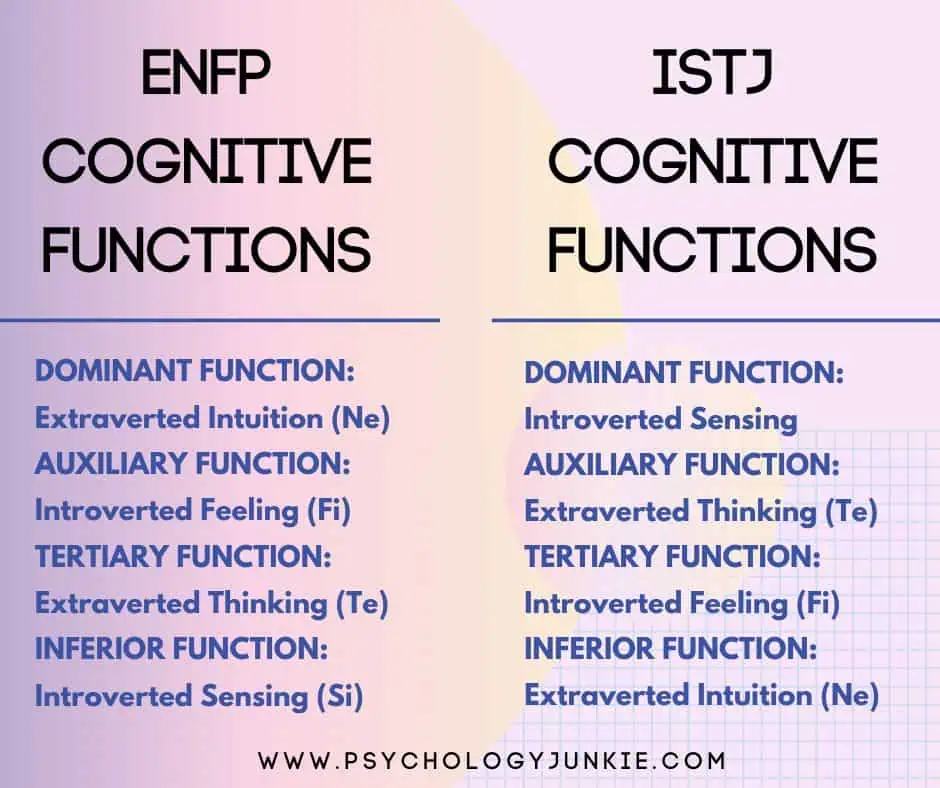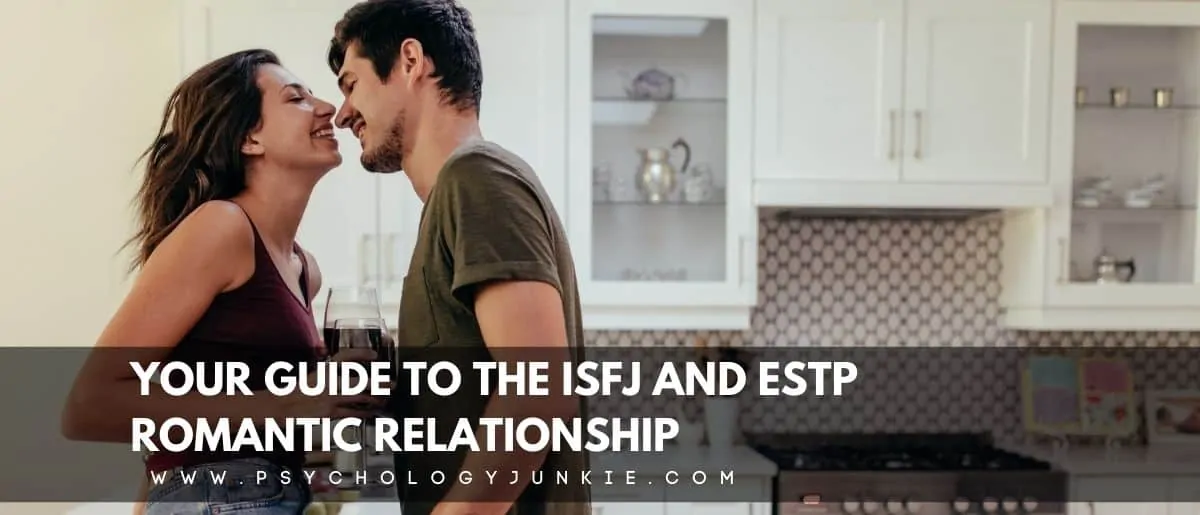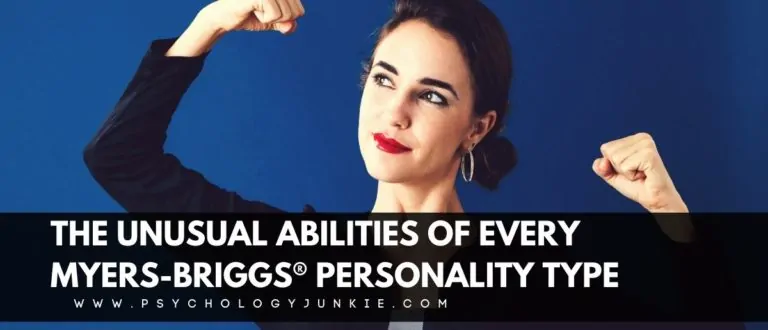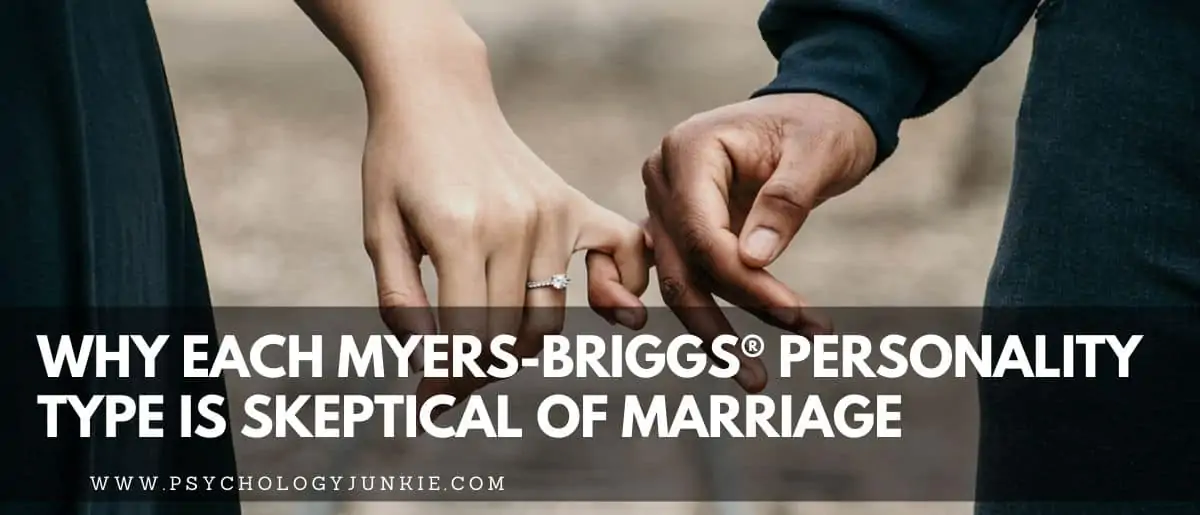The ENFP and ISTJ Relationship: When Opposites Attract
In my years as an MBTI® practitioner, I’ve found again and again that people are romantically attracted to their opposites. If I had a nickel for every time I saw an ENFP/ISTJ relationship, or ESTP/INFJ relationship, or INTP/ESFJ relationship, I’d have….a lot of nickels.
Why is this? I’ve concluded that it comes down to us naturally seeking the yin to your yang, the day to your night – a complementing force that offers balance. With that in mind, today we’re going to delve into the intriguing world of the ENFP and ISTJ relationship – a unique symphony of contrasts. Will it be harmony or discord that prevails? Join us as we unravel this unique blend of personalities.

Not sure what your personality type is? Take our comprehensive personality questionnaire here. Or you can take the official MBTI® here.
An Introduction to ENFPs and ISTJs
Understanding ENFPs
ENFPs, short for Extraverted, Intuitive, Feeling, Perceiving, are enthusiastic, charismatic, and creative individuals that make up an approximate 8% of the general population. They are guided by the following preferences:
- Extraverted (E): ENFPs gain their energy from the external world. They feel more alive when engaging with others, sharing their thoughts, and exploring new experiences.
- Intuitive (N): Instead of focusing on hard facts or details, they tend to lean more towards abstract concepts and underlying patterns. This predisposition allows them to easily grasp future possibilities.
- Feeling (F): ENFPs make decisions based on their emotional compass and inner values, often prioritizing a sense of what’s personally important over cold facts and logic.
- Perceiving (P): This preference signifies their love for spontaneity over strict plans. They are flexible, adaptable, and prefer to keep their options open.
ENFPs are at their best when they have the freedom to explore possibilities. This fuels their creativity and keeps them energized. They are fiercely individualistic and stay true to their core self, refusing to compromise their values for social acceptance. They are the free spirits of the personality world, trailblazing their own unique path.
Understanding ISTJs
ISTJs, standing for Introverted, Sensing, Thinking, Judging, are practical, dedicated, and detail-oriented individuals that constitute about 15% of the population. They are guided by the following preferences:
- Introverted (I): ISTJs draw energy from their inner world. They prefer solitary activities, reflection, and time for analysis.
- Sensing (S): Instead of abstract concepts and patterns, ISTJs focus on concrete facts and details. They rely on past experiences and prefer a hands-on approach in their understanding.
- Thinking (T): ISTJs make decisions based on logic and rationality, prioritizing objective truths over personal sentiments.
- Judging (J): ISTJs have a strong preference for structure and order. They enjoy having a plan and are more comfortable when things are decided.
ISTJs are at their best when there’s a sense of order and predictability in their environment. They are diligent, with a strong sense of duty that drives them to fulfill their responsibilities on time or ahead of schedule. They value integrity and tend to be very loyal to their commitments. They are the quiet heroes of the personality world, ensuring the wheels of society keep turning smoothly.
The Cognitive Functions of ENFPs and ISTJs
In the world of personality theory, cognitive functions are the essence of our psychological makeup, the cogs and wheels driving our thoughts, feelings, and actions. They are our unique ways of perceiving the world and making decisions. Each of us has a set of four primary cognitive functions, ordered in a hierarchy of dominance. Imagine these functions as a team of players inside our minds, each with its peculiar strengths and weaknesses, all working together to navigate the voyage of life.
ENFPs and ISTJs share the same cognitive functions, but their order is reversed. This is one of the key reasons why these two types can seem so different on the surface. Let’s delve into the cognitive function stack of each type:
ENFP Cognitive Function Stack
- Dominant: Extraverted Intuition (Ne): This function allows ENFPs to see numerous possibilities in any situation. They are able to quickly generate ideas and are often innovative thinkers.
- Auxiliary: Introverted Feeling (Fi): This function is tied to ENFPs’ strong sense of internal values. They make decisions based on these values and what feels right to them.
- Tertiary: Extraverted Thinking (Te): This function is used to logically structure and organize the outside world. It helps ENFPs implement their ideas.
- Inferior: Introverted Sensing (Si): This function is one of the weakest for ENFPs. It relates to recalling past experiences and creating a sense of stability based on what’s worked before. This can lead them to sometimes become nostalgic or stuck in the past.
ISTJ Cognitive Function Stack
- Dominant: Introverted Sensing (Si): This function allows ISTJs to rely heavily on their past experiences when making decisions. They value tradition and prefer routines.
- Auxiliary: Extraverted Thinking (Te): This function helps ISTJs to organize their world in a logical manner. They use it to create and implement efficient systems.
- Tertiary: Introverted Feeling (Fi): This function is linked to ISTJs’ value system. Though they primarily make decisions based on logic, their values still play a part.
- Inferior: Extraverted Intuition (Ne): This function is one of the weakest for ISTJs. They tend to be uncomfortable with uncertainty and theory and prefer to stick to what they know and what’s real.
In essence, while both ENFPs and ISTJs have the same cognitive functions, their order results in significantly different behavior and preferences.
5 Benefits to the ENFP & ISTJ Relationship
The merging of ENFP and ISTJ in a relationship is a unique intertwining of polar opposites. Yet, as we delve deeper into this paradoxical pairing, we can see how the “opposites” of these types actually compliment each other. Theirs is a tableau of contrasts and complements, an embodiment of the age-old adage that opposites do indeed attract. The effervescent spontaneity of ENFPs juxtaposed with the calming, structured approach of ISTJs creates a relationship dynamic where each guide each other in the others’ weaknesses. Let’s take a look at the unique strengths of this relationship:
- Mutual Growth: With their innate curiosity and unwavering passion for new adventures, ENFPs have the power to entice ISTJs to venture beyond their familiar boundaries. In return, ISTJs, with their down-to-earth and pragmatic approach, offer ENFPs a sense of stability and a framework for growth. Together, they embark on a journey of mutual development and transformation.
- Finding Harmony: ISTJs’ preference for order and routine can beautifully complement the ENFPs’ spontaneous nature, while the ENFPs’ imaginative and open-minded approach can bring a refreshing twist to ISTJs’ sometimes rigid commitment to tradition.
- Expanding Horizons: With their contrasting perspectives, ENFPs and ISTJs have the power to introduce each other to entirely new ways of seeing the world. This opens the door to a deeper understanding of life and relationships.
- Covering Every Angle: Together, they form a well-rounded team. ISTJs excel at focusing on practical details and implications, while ENFPs are masters of brainstorming and seeing the big picture. This dynamic combination ensures that every aspect of a problem is carefully considered.
- Unveiling Depths: Although it may require effort to truly grasp each other’s differences, once these obstacles are overcome, a profound, almost instinctual understanding of each other’s needs and motivations can emerge. This strengthens their connection and enriches their relationship.
ENFPs, ISTJs, and Introverted Feeling: A Strong Cord of Connection
ISTJs have tertiary introverted feeling (Fi). When Introverted Feeling is in this position, it is an indication that they appreciate being cared for in a manner that aligns with their internal values and beliefs. Their comfort and happiness often hinge on how well their environments and relationships adhere to their deeply-held values. They want a relationship with someone who values their deeper emotional burdens, drives, and convictions. They deeply want to feel “seen” for who they really are in a relationship. While stereotypes would imply that ISTJs are stoic robots; the reality is that underneath their seemingly hard exteriors, nestles a heart that longs for meaningful human connection and a sense of what really matters in life.
Enter the ENFP. Armed with auxiliary Introverted Feeling (Fi), ENFPs care for others by protecting others’ individuality and core values. They tend to nurture relationships based on deep emotional understanding, often going to great lengths to respect and safeguard the values of those they care for. With their sharp insight into human nature, they can typically spot the inner warmth and conviction of the ISTJ’s feeling side. This shared language of introverted feeling can contribute to a poignant emotional connection in ENFP and ISTJ relationships.
How ISTJs Support ENFPs with Extraverted Thinking
The ISTJ, with their auxiliary Extraverted Thinking (Te), is naturally adept at building structured, efficient systems, often implementing practical solutions to problems with a keen focus on order and logic. They extend this practicality and efficiency to their relationships, caring for their loved ones by ensuring stability, order, and consistency. This methodical and objective approach to taking care of others may seem impersonal to some, yet it holds a significant appeal for the ENFPs.
ENFPs, with their tertiary Extraverted Thinking, desire to be cared for with the same consistency and reliability that ISTJs provide. ENFPs, while reveling in their spontaneity and idealism, also seek logistical prowess to bring their many ideas into reality. The logical advice and input offered by ISTJs through their practical and organized care, acts as a grounding force for the ENFP. In the ISTJ’s unyielding commitment to making life efficient and free from chaos, the ENFP finds a sense of peace.
5 Roadblocks to the ENFP & ISTJ Relationship:
As we embark on relationships, it’s inevitable to stumble upon a few thorns that prick us along our journey. ENFPs and ISTJs, despite their many joys, are not immune to these challenges. Here, we explore five potential obstructions that may put a damper on their relationship, along with tips on how to transcend these roadblocks.
- Communication Styles: ENFPs are expressive, known to wear their hearts on their sleeves, while ISTJs are more reserved, expressing their feelings through actions rather than words. This divergence can lead to misunderstandings. To overcome this, both parties need to learn each other’s communication styles, displaying patience and understanding as they navigate their unique linguistic dance. ENFPs should understand that just because ISTJs are quiet, it doesn’t mean they don’t care. ISTJs should also take the time to verbalize their emotions and acknowledge the ENFPs’ need for expression
- Different Rhythms: The spontaneous spirit of ENFPs may clash with the structured nature of ISTJs, causing friction. It’s essential for both personalities to recognize these differences as strengths that can bring balance rather than as sources of conflict. Mutual respect and compromise are the keys to finding harmony in their rhythms.
- Dealing with Change: ENFPs thrive in change, viewing it as an exciting adventure. ISTJs, however, find comfort in predictability. This dichotomy can cause tension. The solution lies, as it often does, in open dialogue and compromise—ENFPs should provide ISTJs with a sense of stability, while ISTJs must learn to embrace the winds of change time and again. ENFPs need some open-ended time for exploration and discovery, and ISTJs need some structured time to focus on their own hobbies.
- Planning vs. Living in the Moment: ISTJs favor long-term planning, while ENFPs prefer living in the moment. This divergence can lead to disagreements about future decisions. The solution? Respect each other’s preferences and work towards a middle ground—blending careful planning with the joy of spontaneous living.
- Introversion vs. Extroversion: ISTJs are introverted by nature, meaning they draw energy from solitary activities and require time alone to recharge. On the contrary, ENFPs are extroverted, gaining energy from social interactions and thriving in lively environments. This difference can lead to disagreements about social activities and time spent together or apart. To negotiate this potential roadblock, both parties need to respect each other’s social preferences. ENFPs could benefit from understanding the ISTJ’s need for solitude and personal space, while ISTJs may need to occasionally step outside their comfort zones and engage in social activities with their ENFP partners. With understanding, compromise, and open communication, this contrast can be transformed into an opportunity for growth and learning in their relationship.
Being Sensitive with the Inferior Function
One thing to keep aware of is that in this relationship each partner is likely to overwhelm the other by being dominant in an area that the other type is weak. For example, an ISTJ is dominant in Introverted Sensing; this is a function that an ENFP feels vulnerable in and may get overwhelmed by easily. If an ISTJ is throwing a bunch of details at the ENFP or expecting them to track a lot of specifics, the ENFP may feel overwhelmed, frustrated, defensive, and/or vulnerable. Simultaneously, if the ENFP is throwing a bunch of ideas and random hypotheses at the ISTJ, the ISTJ might feel overwhelmed, defensive, irritable, or vulnerable.
This doesn’t mean that both types should put a lid on who they are or expressing their strengths. It does mean having a dose of consideration for your partner. Pause. Take a breather now and then. Ask your partner’s perspective in their language. For example, if you’re an ENFP and you’re tossing out a bunch of ideas about what you should do for vacation, pause, and ask your ISTJ “Is this too many ideas at once? Do you need some time to process?” or you could ask, “What vacation ideas have you always enjoyed in the past?” or “How could I choose a vacation spot that honors your specific tastes?”
If you’re an ISTJ and you’re throwing a lot of specific details at an ENFP and expecting them to follow, take a moment to consider that they may be struggling. Ask them if they need you to slow down or pause. Ask them if they have any questions. And give them opportunities to innovate and explore as well. If they’re doing something differently than the way you’ve always done it, ask yourself if it really matters on a deep level if they adhere to your way of doing things or if they mix it up. Try not to correct them or critique them if what they’re doing is not actually causing a problem.
What Are Your Thoughts?
We would love to hear your insights and experiences as well! Have you been in an ENFP and ISTJ relationship? Or do you know someone who has? What challenges and joys have you encountered? Your unique stories and perspectives enrich our understanding of these intriguing personality dynamics. Please feel free to share your thoughts, experiences, or questions in the comments below. Your voice matters to us.
Other Articles You Might Enjoy:
Here’s How You’re Misunderstood in Relationships, Based On Your Myers-Briggs® Personality Type
What Each Myers-Briggs® Personality Type Needs in a Long-Term Relationship
Your Biggest Relationship Fear, Based On Your Myers-Briggs® Personality Type
References:
The 16 Personality Types: Descriptions for Self-Discovery by Linda V. Berens and Dario Nardi (1999, InterStrength)
16 Ways to Love Your Lover: Understanding the 16 Personality Types So You Can Create a Love That Lasts Forever by Otto Kroeger & Janet M. Thuesen (1994, Dell Publishing)














Can you do this for ESTP and INFJ? Our 18 year marriage has been incredibly hard…
I’ve written an article for this pairing! I’m sorry that it’s been so difficult, and I hope the article can help! It’s right here: https://www.psychologyjunkie.com/infjs-estps-fall-love-joys-struggles/
I (ENFP) fall for an ISTJ. We’ve known each other for about 5 years now. I told him I like him and he just smiled. All this time I’m trying to be patience, but I start to lose my patience. What are we actually?
I asked him once, he said if he likes someone or vice versa, he would just know and won’t say anything. While I understand maybe labellings isn’t his preference, I’d like to know if I’m wasting my time. He doesn’t text, doesn’t make plan…basically nothing, but I know we feel good with each other’s presence. I don’t want to push it but I think 5 years is cutting it.
Love it! 🎯
13 years of marriage ISTJ (she) with ENFP (he) ☺️
Discovering MBTI was a real game-changer for us. All you said in this article is true and working for us.
Thank you for doing this and helping people to know themselves and than understand others.